MPD: Microwave Product Digest
Current Innovations In Phase Stable Coaxial Cable Design
by Times Microwave Systems
Originally Published in Microwave Product Digest
Why Are Phase Stable Cables Important?
Radio frequency and microwave systems have become increasingly sensitive to phase variations of their sub assemblies and components. Cable assemblies, that form the interconnecting backbone of these systems, can be a significant source of poor system performance unless proper choices are made when selecting and designing these components. The development of a new Dielectric material, TF4™, now gives the system designer a previously unavailable option with far better phase performance than PTFE, Si02 or other conventional cables. For many applications this is critical to achieving required system performance.
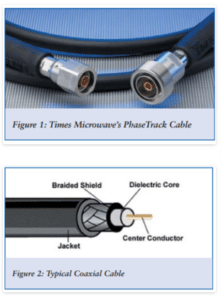
Satellite and military aircraft often deploy Synthetic Aperture RADAR (SAR) systems that use multi-element co-planar arrays and interferometry techniques. Lower magnitude of phase change and better phase tracking with changing temperatures result in lower residual errors and uncertainties. This contributes to very controllable and consistent beam steering, beamwidth and sidelobe suppression. Antenna gain, minimum discernable signal levels, system range, jamming and clutter resistance are all enhanced. In short, overall system performance and accuracy will be significantly improved.
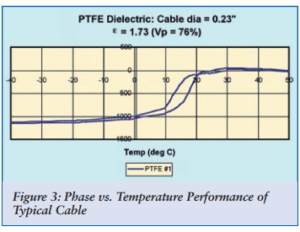
Many wireless applications use switched beam and adaptive array antenna systems. Bit error rates, especially on signals close to the receiver noise floor, will be better, effectively increasing range. These systems can greatly increase their coverage area and make most efficient use of available bandwidth when stable components are used.
The test and measurement community benefits from highly phase stable cable assemblies as well. One of the largest contributors to measurement uncertainty is temperature-related drift of the systematic errors. Interconnections that are highly phase stable, as a function of changing temperature, can greatly extend the length of time between calibrations and can minimize the amount of drift between calibrations. This is of particular benefit to people who are making measurements in hangars, on flight lines or outdoors; anywhere that temperature is fluctuating. This could allow cellular base station maintenance personnel the option of calibrating inside the equipment shelter and then going outside, into the weather, to make their measurements. Vector Network Analyzers (VNAs) and Vector Signal Analyzers (VSAs) are both highly phase sensitive instruments. Test personnel should use the most phase stable cables obtainable when making measurements with these sensitive devices.
What is the Current State of Technology?
In the 1970s and 1980s, before RF and microwave systems became phase sensitive,
Polytetroflourethelene (PTFE) became widely used as the dielectric propagation medium in high performance coaxial cable assemblies. PTFE, or Teflon™ as it is more commonly known, is a very good choice of material for this application. It has very low attenuation at microwave frequencies and its electrical and mechanical properties are relatively constant over a wide range of temperatures.
As the quest for lower attenuation progressed, and frequency ranges were increased, cables were constructed of lower dielectric constant, expanded PTFE materials. Systems became increasingly sensitive to phase changes in their sub-systems and components. Cable designers carefully optimized their constructions and processes to minimize the electrical length changes of the cable and cable assemblies. Due to the physics inherent in PTFE the stability of PTFE based cable can only be reduced to finite limits.
Silicon Dioxide dielectrics have also been used with great success. It is impossible to manufacture flexible cable using SIO2 as the dielectric. This type of cable must be manufactured as a rigid, or semi-rigid, construction.
The search is on for a flexible alternative that has extremely low phase change with temperature and yet maintains all of the benefits of a lightweight, flexible cable.
What is “Electrical Length?
A single frequency, step function stimulus, when launched into a cable assembly, can be thought of as a rotating voltage vector whose angular velocity (deg/sec) is equal to 360 times the frequency. This voltage vector rotates at this angular velocity for an amount of time equal to the propagation delay of the cable assembly. The product of the propagation delay and the angular velocity of the applied voltage vector are known as the electrical length of the cable assembly.
Consider a case of an X Band SAR transmitter feeding an antenna element. The frequency of the applied signal is 9.5 GHz and the propagation time delay of the cable assembly is 3 nano-seconds. The electrical length of the cable, in degrees, can be calculated by, what is essentially, a simple “distance equals rate times time” formula:
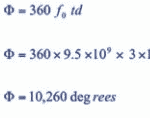
The propagation delay of the cable assembly is a function of the physical length, velocity of light and the net dielectric constant of the propagation medium.
If we assume that our antenna cable has a dielectric constant of 2.04 and the physical length is 24.8 inches the propagation delay can be calculated by:
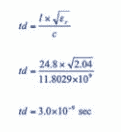
Substituting the time delay calculation into the electrical length formula provides the complete relationship between electrical length and the appropriate electrical and physical properties of the cable.
The frequency is held constant and the velocity of light is constant. The only variables in the electrical length equation are physical length and net dielectric constant of the propagation medium.
Why Does Electrical Length Change With Temperature?
Most high quality, high performance coaxial cables are made using dielectric materials whose dielectric constant is very stable across a relatively wide range of temperatures. The dielectric constant, of the base material (i.e. PTFE or Silicon Dioxide), is constant for all practical purposes. As the environmental temperature changes around the cable the metal conductors of the coaxial structure undergo a well-understood thermal expansion/ contraction. Copper expands at a rate of 17 PPM per degree Celsius. The physical length of the cable will change directly proportional to the thermal coefficient of expansion. It is self evident that the electrical length will change in proportion to the physical length change.
From the simplified diagram of a typical coaxial cable it is clear that the center conductor’s expansion and contraction directly effects the physical length and thus the electrical length. The effects of the expansion and contraction of the braided outer conductor is a bit more interesting and complex. The individual conductors, that comprise the braid, are wrapped around the circumference of the dielectric core. When they expand and contract they do not lengthen and shorten the physical length of the cable assembly. Instead they tend to tighten and loosen themselves upon the core.
A coaxial structure, when stabilized at room ambient temperature (about +25º C), will have a certain amount of constrictive force imparted into the dielectric core by the braids and subsequent outer layers within the cable. When measuring electrical length stability, as a function of dynamic temperature, it is common to use this condition as a basis against which phase stability is measured. The relative net dielectric constant of the core, and its relative density, can be normalized to 1 at this starting point. As temperature changes the amount of constrictive force imparted into the dielectric increases or decreases. This causes the relative density of the dielectric (and therefore the net dielectric constant) of the propagation medium to change.
For example: When temperature is decreasing the physical length is decreasing. The physical length of the braids are decreasing as well causing the relative density of the dielectric to increase and the dielectric constant to increase. The net effect on electrical length is that the effects of the changing physical length are opposite to the dielectric constant changes. In typical cable the effects of the dielectric are much greater than the effects of the physical length changes.
Phase Vs. Temperature Performance of Typical Cable
Traditional high-performance cables, for nonphase critical applications, are typically made of expanded PTFE dielectric. The relative dielectric constant of this class of cable is about 1.73. This cable is relatively dense and undergoes significant phase change as a function of temperature. It is common for these types of cables to have maximum phase changes of over 2500 PPM. These cables were designed without regard to phase stability. They were optimized to have the lowest attenuation possible.
How to Overcome These Problems
As radio frequency and microwave systems became increasingly phase sensitive it became clear to cable manufacturers that designs would have to be significantly improved to meet the performance demanded by the industry. Since the metal and dielectric effects have opposite temperature slopes it stands to reason that a balance should be possible. Through mechanical and process design the typical balance illustrated below is commonly achieved.
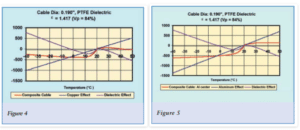
It is absolutely imperative that the design, materials and processes be considered simultaneously. Changing materials, without changing the mechanical design will no longer yield optimum results. Using the best materials for a particular design is no guarantee of success unless the processes are optimized and monitored closely. When the exact design and process used to make the cable whose response is illustrated in Figure 4 is constructed by replacing the copper center conductor with an aluminum center conductor the results are clear. Phase stability has been significantly degraded.
What About That “Knee?”
PTFE, in many ways, is the perfect material for RF and microwave dielectrics. It has a very low loss tangent and the electrical properties are virtually constant across a wide range of temperatures. Unfortunately, this material has one very significant shortcoming. At around +18 degrees C (65 F) the material undergoes a molecular phase transition. When transiting through this band of temperatures the material undergoes a “step function” change in dielectric constant. Along with this change in dielectric constant is an abrupt change in electrical length. This is commonly known as the Teflon™ “knee”.
The dielectric and metal effects on electrical length can be balanced above and below this phase transition band of temperatures. But the laws of physics are irrefutable. The knee will always be present in PTFE dielectric cable.
The Only Option Is To Find Another Material
For many years the best material on the market was Silicon Dioxide. SIO2 is a very good cable. It has reasonable attenuation characteristics, although significantly higher than PTFE. It has a very high temperature rating and has an essentially linear phase vs. temperature slope.
Problem Solved, Right?
SIO2 is a ceramic material that is quite brittle. The only practical coaxial cable that can be made with this material is a semi-rigid cable. Semi-rigid cable has many deficiencies in that it is difficult to make in long lengths and precise bend data must be supplied when making cable assemblies. Another avenue was needed to achieve linear phase stability in a flexible coax structure.
Phase Stable and Flexible
TF4 is a proprietary flouropolymer material process, developed by Times Microwave Systems, to specifically address this issue. This is a plastic material that has an extremely linear phase temperature characteristic. By employing this material, and the correct design and process measures, a very good balance between dielectric and metal effects has been achieved.
How Does TF4 Technology Compare?
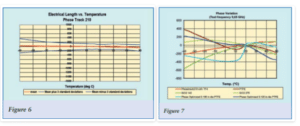
Figure 7 compares the phase vs. temperature characteristics of a variety of cable options. There are several phase optimized PTFE constructions, two silicon dioxide constructions and the PhaseTrack 210 using TF4 technology. The PhaseTrack cable offers the system designer the option of using a flexible cable with much better phase stability than previously available options, resulting in enhanced system performance.
TF 4™ is a trademark of Times Microwave. Teflon™ is a trademark of Du Pont.
Subscribe to our newsletter!
Interested in receiving email newsletters and other updates from Times? Subscribe now!
